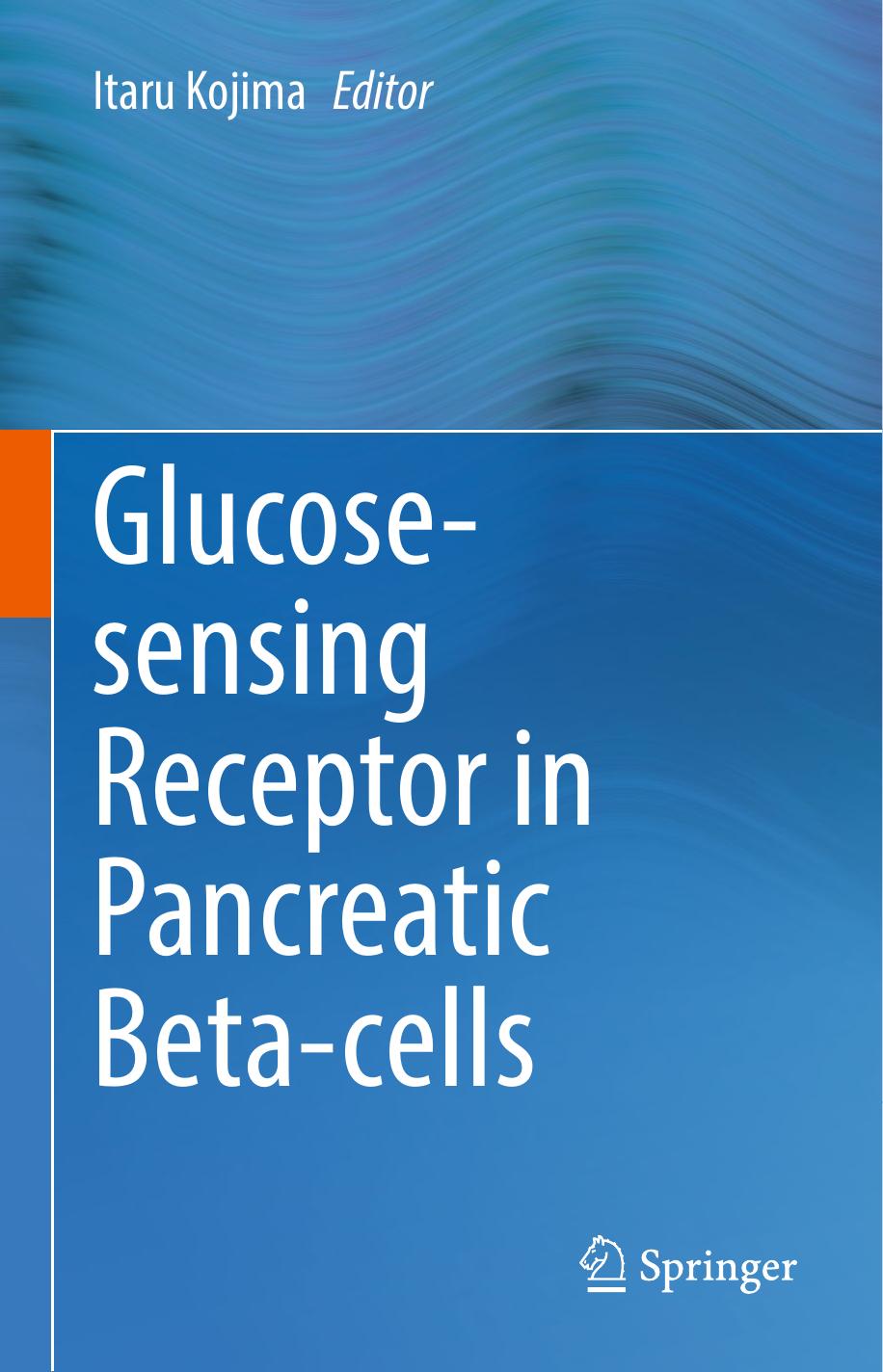Glucose-sensing Receptor in Pancreatic Beta-cells by Itaru Kojima

Author:Itaru Kojima
Language: eng
Format: epub, pdf
Publisher: Springer Singapore, Singapore
In addition to the above-mentioned reports, several lines of evidence supporting the “glucoreceptor hypothesis” have been reported. There is no difference in glucose transport between α- and β-anomers in various cells including β cells, or in some situations, the β-anomer predominates [2, 3]. Glucokinase expressed in pancreatic β cells does not discriminate anomeric differences [5, 6]. In addition, once glucose is phosphorylated, the rate of interconversion of anomers becomes 270 times higher, and at down-stream steps, both anomers of glucose are equally potent in β-cells [5]. Also, the production of H 2 O by the two anomers is comparable [2, 7]. The concentration of glucose-6-phosphate is roughly comparable whether extracellular D-glucose is α-anomer or β-anomer, but rather, it is higher in the case of β-anomer [2, 7–9]. All of these results strongly support the “glucoreceptor hypothesis.”
On the other hand, regarding the metabolic hypothesis, Malaisse and colleagues highlighted phosphoglucose isomerase, an enzyme that converts glucose 6-phosphate to fructose 6-phosphate. They showed that phosphoglucose isomerase is more efficient for α-anomer, and postulated that the difference in the action of α- and β-anomers depends on “metabolism” [8, 9].
In 1979, Niki and colleagues again stimulated β-cells by mannose anomers and compared insulin secretion induced by two anomers, focusing on phosphomannose isomerase. This enzyme more efficiently catalyzes the β-anomer. Accordingly, it is expected that if the structure of anomers is recognized by the enzyme, β-anomer is more potent in stimulating insulin secretion. Nevertheless, insulin secretion induced by the α-anomer of mannose is more similar to that induced by the β-anomer [10].
In 1983, Matchinsky reported that glucokinase, which was previously thought to be unable to distinguish α- and β-anomers, specifically recognizes α-anomer. They suggested that glucokinase perceives anomeric differences and causes a difference in insulin secretion. They also suggested that this glucokinase is a glucose sensor, since the Km value and the V max value of glucokinase for glucose and mannose agree with the respective values of glucose metabolism in pancreatic β-cells. Their work provided support for the “metabolic hypothesis.”
Meanwhile, results supporting the “glucoreceptor hypothesis” have been reported. Mannoheptulose is a metabolic inhibitor of glucokinase and has been shown to inhibit secretion of insulin. In 1988, Wolf and colleagues permeabilized plasma membrane of pancreatic β-cells with digitonin. Using these permeabilized cells, they showed that mannoheptulose inhibits glucose action even in the absence of glucose phosphorylation [ 11 ]. These data suggest that mannoheptulose acts on a molecule(s) distinct from glucokinase and inhibits insulin secretion. In other words, glucose is capable of stimulating insulin secretion in a condition without glucose metabolism, and mannoheptulose inhibits glucose-induced secretion in this condition by acting on other target molecules. Since mannoheptulose tastes sweet, it is an interesting possibility that it acts on the sweet taste receptor or related molecules. In this regard, p -nitrophenyl-D-glucopyranoside (PNP-Glu), which is known as an inhibitor of the sweet taste receptor in the tongue, has a strong inhibitory effect on the α anomer. Indeed, PNP-Glu also suppresses glucose-induced insulin secretion in pancreatic islets. It inhibits insulin
Download
Glucose-sensing Receptor in Pancreatic Beta-cells by Itaru Kojima.pdf
This site does not store any files on its server. We only index and link to content provided by other sites. Please contact the content providers to delete copyright contents if any and email us, we'll remove relevant links or contents immediately.
| Administration & Medicine Economics | Allied Health Professions |
| Basic Sciences | Dentistry |
| History | Medical Informatics |
| Medicine | Nursing |
| Pharmacology | Psychology |
| Research | Veterinary Medicine |
Tuesdays with Morrie by Mitch Albom(4692)
Yoga Anatomy by Kaminoff Leslie(4306)
Science and Development of Muscle Hypertrophy by Brad Schoenfeld(4089)
Bodyweight Strength Training: 12 Weeks to Build Muscle and Burn Fat by Jay Cardiello(3915)
Introduction to Kinesiology by Shirl J. Hoffman(3726)
How Music Works by David Byrne(3187)
Sapiens and Homo Deus by Yuval Noah Harari(2987)
The Plant Paradox by Dr. Steven R. Gundry M.D(2547)
Churchill by Paul Johnson(2506)
Insomniac City by Bill Hayes(2499)
Coroner's Journal by Louis Cataldie(2433)
Hashimoto's Protocol by Izabella Wentz PharmD(2331)
The Chimp Paradox by Peters Dr Steve(2298)
The Universe Inside You by Brian Clegg(2097)
Don't Look Behind You by Lois Duncan(2080)
The Immune System Recovery Plan by Susan Blum(2029)
The Hot Zone by Richard Preston(1983)
Endure by Alex Hutchinson(1964)
Woman: An Intimate Geography by Natalie Angier(1882)
